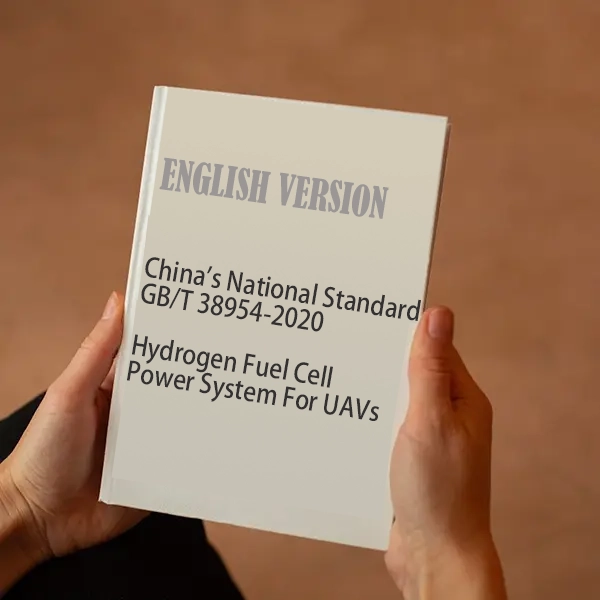Hydrogen is not all the same. Depending on how it’s made, the environmental impact of hydrogen varies a lot. People often talk about "grey hydrogen1," "blue hydrogen2," and "green hydrogen3." These categories are based on how much carbon dioxide is released when the hydrogen is produced. I think it’s important to understand the differences, especially now that many countries are pushing for cleaner energy options. Let me explain what I’ve learned as I work in the hydrogen drone industry, where these distinctions are more than just theory—they shape real decisions.
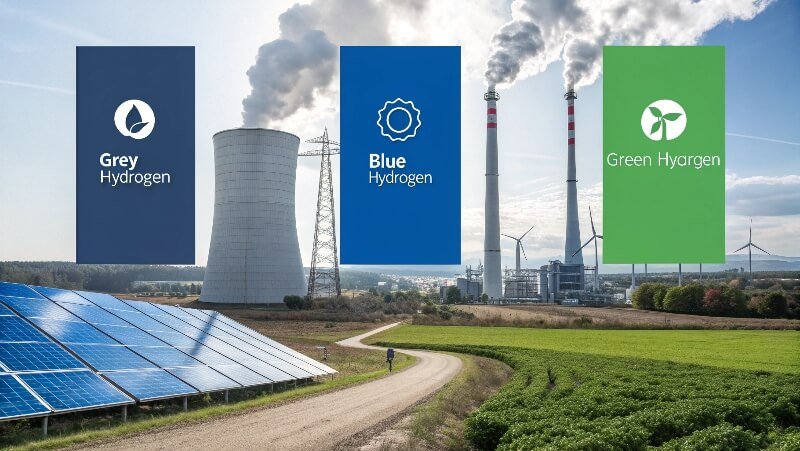
Grey Hydrogen: Fossil Fuel-Based and Carbon-Heavy
Grey hydrogen is the most common type and also the most polluting.
Most of the hydrogen used today is made from fossil fuels like natural gas, coal, or oil. The method usually involves steam methane reforming (SMR). In this process, methane (CH₄) reacts with high-temperature steam to produce hydrogen and carbon monoxide. The carbon monoxide then reacts again to create more hydrogen and carbon dioxide.
I’ve seen that in industrial settings, this method is well-developed. It’s cheap and reliable. But the carbon emissions are huge. Every ton of hydrogen produced can release up to 12 tons of carbon dioxide. That’s why grey hydrogen is seen as unsustainable.
Coal gasification is another way to produce grey hydrogen. It uses coal and steam to make a mixture of gases, including hydrogen. This method is even worse in terms of emissions. Still, it’s used because coal is cheap and available in many countries.
Grey hydrogen is cheap, but its environmental cost is very high.
The cost of making grey hydrogen is usually between $1.5 and $2.5 per kilogram. This is mainly because fossil fuels are still cheap in many regions. The technology is mature, and factories that make hydrogen this way have been around for decades. That’s why, right now, around 95% of all hydrogen is grey.
But this type of hydrogen will face increasing limits. Governments are setting emission targets. Carbon taxes and environmental rules are pushing industries to move away from high-emission energy sources like grey hydrogen.
Grey hydrogen is widely used in oil refining, chemical production, and steel.
Hydrogen helps remove sulfur and other unwanted elements from fuel in refineries. It’s also a key part of making ammonia for fertilizers and methanol for chemicals. In steelmaking, hydrogen is slowly being used to reduce iron instead of using coal. Right now, grey hydrogen is still the main source, but that’s changing.
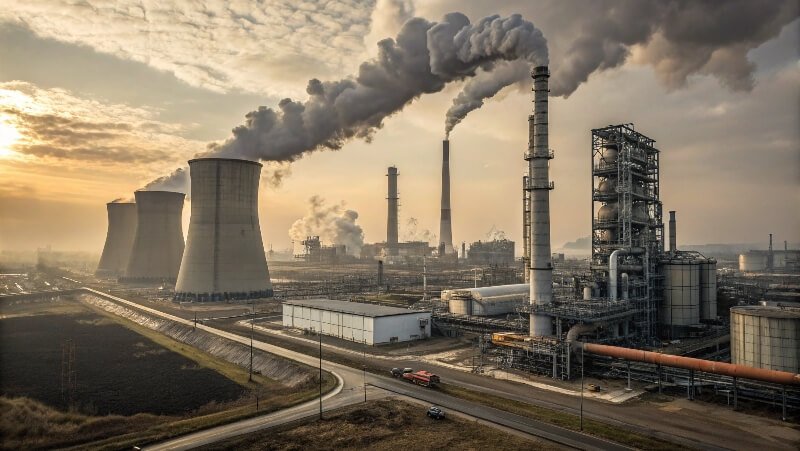
Blue Hydrogen: Fossil Fuels Plus Carbon Capture
Blue hydrogen is a cleaner version of grey hydrogen. It uses the same process but adds carbon capture to reduce emissions.
This type of hydrogen is still made using fossil fuels, mostly natural gas. But instead of releasing all the carbon dioxide into the air, factories use carbon capture, utilization, and storage (CCUS) systems. These systems trap carbon before it can escape into the atmosphere.
Captured carbon can be stored underground or reused in other processes. Some companies use it to extract more oil from old wells. Others try to turn it into building materials or chemicals. The goal is to keep carbon out of the air.
Blue hydrogen can cut carbon emissions by 50% to 90% compared to grey hydrogen.
I find this a helpful middle step. It allows us to keep using familiar technology while reducing environmental harm. But blue hydrogen isn’t perfect. It still depends on fossil fuels. And CCUS systems are not always reliable. If storage leaks or systems fail, the carbon goes back into the air.
Blue hydrogen is more expensive than grey hydrogen because of the extra equipment.
Adding carbon capture technology increases both the cost and complexity of hydrogen production. The typical cost is $0.5 to $1 higher per kilogram than grey hydrogen. These costs come from building carbon capture units, compressing the gas, and storing it. The energy needed to run these systems also adds to the total cost.
Some companies already use blue hydrogen to lower emissions in fertilizer and chemical plants.
I’ve read about pilot projects in Europe and North America. In one example, a large chemical company switched part of its ammonia production to blue hydrogen. They combined hydrogen from natural gas with CCUS to cut emissions. It’s not zero-carbon, but it helps meet climate goals in a practical way.
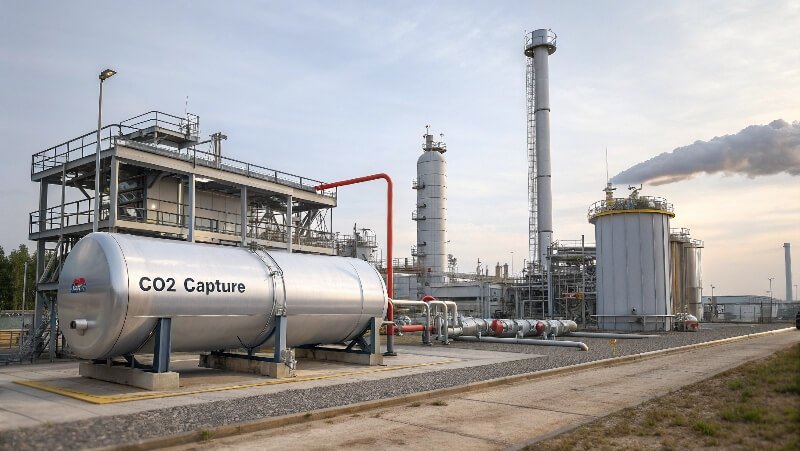
Green Hydrogen: Cleanest But Costly
Green hydrogen is made using renewable energy and has almost no carbon emissions.
This is the type of hydrogen I care about most, because it fits with long-term sustainability goals. The main method is electrolysis. That means using electricity from sources like wind or solar to split water into hydrogen and oxygen. If the electricity is clean, the hydrogen is also clean.
The only emissions come from making and maintaining the equipment. These are small compared to the emissions from fossil fuels. That’s why many researchers call green hydrogen “zero-carbon hydrogen.”
Green hydrogen is the most expensive today, but prices are dropping fast.
Electrolysis needs a lot of electricity, and renewable power can still be expensive in some places. Also, the machines that split water—called electrolyzers—are not cheap or efficient yet. That’s why green hydrogen can cost between $3 and $6 per kilogram, depending on where and how it’s made.
But I’ve seen hopeful signs. In some regions, solar power is now the cheapest form of electricity. Also, new electrolyzer designs are being tested. Some use less water or work better at low temperatures. These upgrades can lower the cost of green hydrogen. Experts think that by 2030, the price could drop to around $2–$3 per kilogram.
Green hydrogen can replace fossil fuels in transport, heavy industry, and energy storage.
In my work with hydrogen-powered drones, green hydrogen is the top choice. It lets us operate without adding to pollution. In larger settings, buses and trucks powered by hydrogen fuel cells are already running in cities in Japan and Europe.
In factories, green hydrogen can heat high-temperature furnaces or power boilers. In the chemical industry, it can replace grey hydrogen in making ammonia or methanol.
Green hydrogen can also be stored when renewable electricity is not needed. Later, it can be used to make electricity again when the sun isn’t shining or the wind isn’t blowing. This helps balance the energy grid.
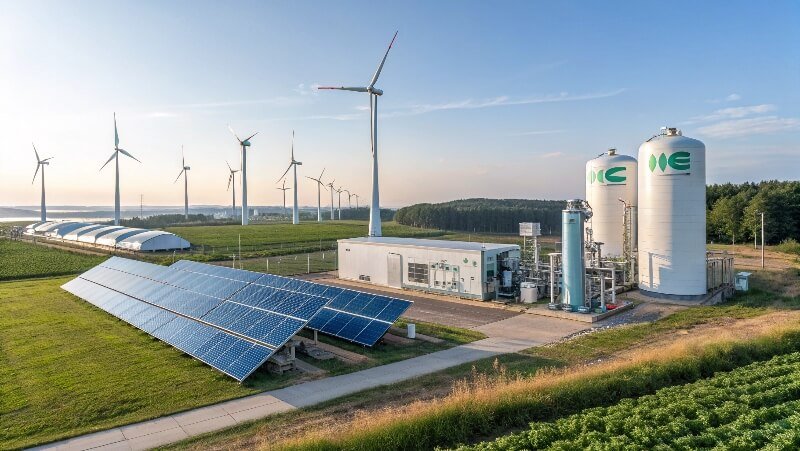
Comparing the Three Types
Grey hydrogen has the lowest cost but the highest emissions.
That’s the trade-off we have to understand. It’s affordable and easy to make but terrible for the planet.
Blue hydrogen reduces emissions but adds costs and risks.
It gives us a cleaner option while still using fossil fuels. But it depends on expensive and imperfect carbon capture systems.
Green hydrogen is the cleanest but still costly and limited by renewable power.
It’s the best long-term solution, especially as renewables get cheaper. But it will take time to scale up.
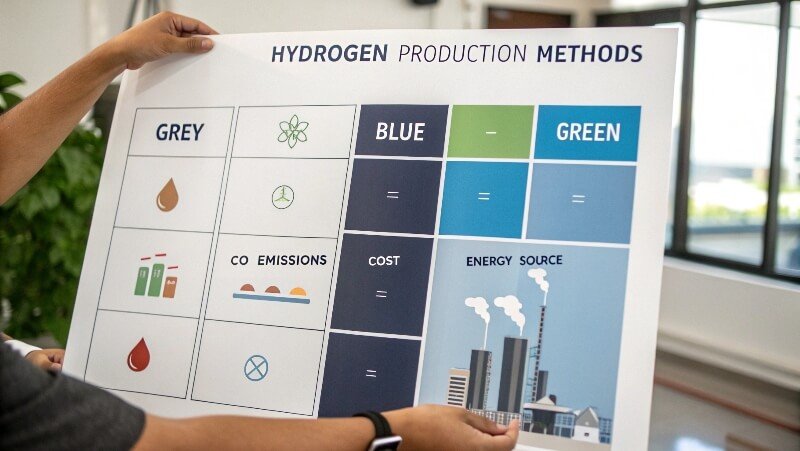
Conclusion
Each type of hydrogen has its own place in the energy transition.
Grey hydrogen has helped industries for decades, but it’s time to move on. Blue hydrogen offers a cleaner way to keep current systems running. Green hydrogen points to a zero-emission future.
In my work, I push for green hydrogen where possible. But I know that change takes time and money. That’s why it’s important to understand these three types. We can make better choices when we know the impact of each one.
I hope to see more investments in green hydrogen production. Better electrolyzers and cheaper solar power can make clean hydrogen the new normal. Until then, we need to use all options wisely, step by step.
-
Discover the environmental consequences of grey hydrogen production and why it’s crucial to transition to cleaner alternatives. ↩
-
This link will help you understand the role of blue hydrogen in reducing emissions and its importance in the transition to cleaner energy. ↩
-
Exploring this resource will provide insights into how green hydrogen can revolutionize energy sustainability and its potential applications. ↩


